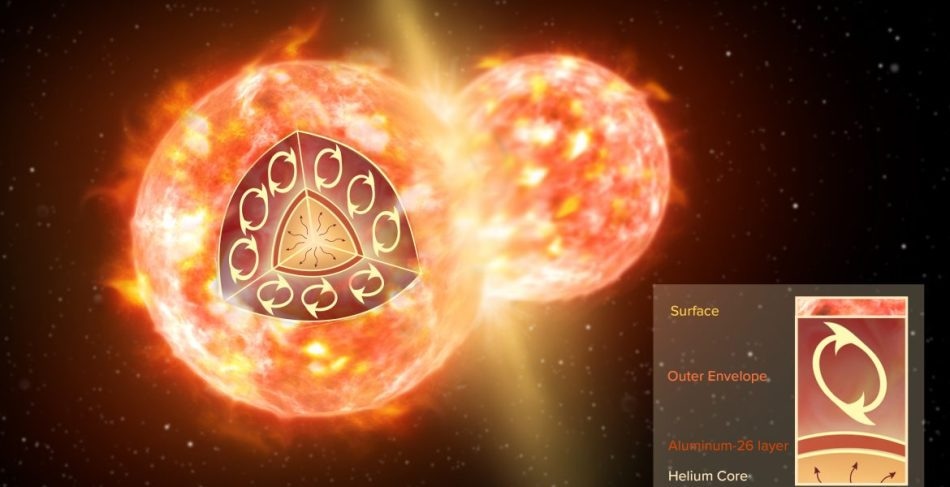Jul 31 2018
The result of the collision between two Sun-like stars can be an extravagant explosion and the formation of a completely new star. In 1670, one such event was observed from Earth and appeared to observers as a bright, red “new star.”
 This is an artist impression of the collision of two stars, like the ones that formed CK Vul. The inset illustrates the inner structure of one red giant before the merger. A thin layer of 26-aluminum (brown) surrounds a helium core. An extended convective envelope (not to scale), which forms the outermost layer of the star, can mix material from inside the star to the surface, but it never reaches deep enough to dredge 26-aluminum up to the surface. Only a collision with another star can disperse 26-aluminum. (Image credit: NRAO/AUI/NSF; S. Dagnello)
This is an artist impression of the collision of two stars, like the ones that formed CK Vul. The inset illustrates the inner structure of one red giant before the merger. A thin layer of 26-aluminum (brown) surrounds a helium core. An extended convective envelope (not to scale), which forms the outermost layer of the star, can mix material from inside the star to the surface, but it never reaches deep enough to dredge 26-aluminum up to the surface. Only a collision with another star can disperse 26-aluminum. (Image credit: NRAO/AUI/NSF; S. Dagnello)
Although at first it was visible to the naked eye, the burst of cosmic light rapidly faded and now necessitates the use of robust telescopes to observe the remains of this merger: a dim central star surrounded by a halo of glowing material flowing away from it.
Nearly 348 years after this event, an international group of astronomers have used the Atacama Large Millimeter/submillimeter Array (ALMA) and the Northern Extended Millimeter Array (NOEMA) radio telescopes to investigate the remains of this explosive stellar merger - called CK Vulpeculae (CK Vul) - and found out the evident and convincing signature of a radioactive version of aluminum (26Al, an atom consisting of 13 protons and 13 neutrons) attached with atoms of fluorine, forming 26-aluminum monofluoride (26AlF).
This is the first molecule to bear an unstable radioisotope conclusively detected outside of our solar system. Unstable isotopes surplus nuclear energy and ultimately decay into a stable, less-radioactive form. In this case, the 26-aluminum (26Al) decays to 26-magnesium (26Mg).
“The first solid detection of this kind of radioactive molecule is an important milestone in our exploration of the cool molecular universe,” stated Tomasz Kamiński, an astronomer with the Harvard-Smithsonian Center for Astrophysics in Cambridge, Massachusetts, and lead author on a paper published in Nature Astronomy.
The scientists observed the distinctive spectral signature of these molecules in the debris surrounding CK Vul, which is located nearly 2000 light-years from Earth. While spinning and tumbling through space, these molecules emit a unique fingerprint of millimeter-wavelength light, a process called “rotational transition.” Astronomers believe this is the “gold standard” for molecular detections.
These attributive molecular fingerprints are generally taken from laboratory experiments and then employed to identify molecules in space. However, this technique is not applicable in the case of 26AlF since 26-aluminum does not exist on Earth. Hence, laboratory astrophysicists from the University of Kassel/Germany used the fingerprint data of abundant and stable 27AlF molecules to obtain accurate data for the rare 26AlF molecule.
This method of extrapolation is based on the so-called Dunham approach. It allows researchers to precisely calculate the rotational transitions of 26AlF with an accuracy far beyond the needs of astronomical observers.
Alexander Breier from the Kassel team
The observation of this specific isotopologue offers a new understanding of the merger process that formed CK Vul. It also shows that the deep, dense inner layers of a star, where radioactive isotopes and heavy elements are forged, can be agitated and cast into space by stellar collisions. “We are observing the guts of a star torn apart three centuries ago by a collision,” noted Kamiński. “How cool is that?”
The astronomers also concluded that mass of the two stars that merged was comparatively low, where one was a red giant star with a mass almost 0.8–2.5 times that of our Sun.
This first direct observation of this isotope in a stellar-like object is also important in the broader context of galactic chemical evolution. This is the first time an active producer of the radioactive nuclide 26Al has been directly observationally identified.
Tomasz Kamiński
For several decades, it has been known that nearly three entire Suns’ worth of 26Al is spread over the Milky Way galaxy. However, these observations, carried out at gamma-ray wavelengths, were able to identify only that the signal was there and could not identify individual sources; it was also ambiguous how the isotopes reached there.
The astronomers concluded that the current estimates on the mass of 26Al in CK Vul (with a mass of nearly one-quarter the mass of Pluto) and the rare incidence of mergers such as this indicate that it is quite improbable that mergers are entirely responsible for this galactic radioactive material.
However, NOEMA and ALMA have the ability to detect only the amount of 26Al bound with fluorine. The actual mass of 26Al in CK Vul (in atomic form) could be considerably greater. Chances are that other merger remnants could exist in considerably greater amounts. It is also possible that astronomers have underestimated the prevalent merger rates in the Milky Way. “So this is not a closed issue and the role of mergers may be non-negligible,” noted Kamiński.